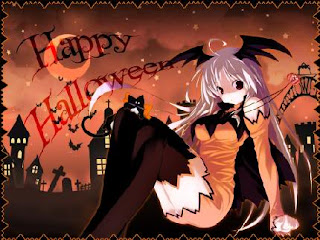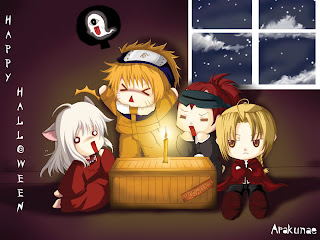
Scotland, having a shared Gaelic culture with Ireland, has celebrated the festival of Samhain (pronounced Sow-win) robustly for many centuries. The autumn festival is pre-Christian Celtic in origin, and is known in Scottish Gaelic as Oidhche Shamhna, the "Summer's night." During the fire festival, souls of the dead wander the Earth and are free to return to the mortal world until dawn. Traditionally, bonfires and lanterns (samhnag in Scottish Gaelic) would be lit to ward off the phantoms and evil spirits that emerge at midnight. The term Samhainn or Samhuinn is used for the harvest feast, and an t-Samhain is used for the entire month of November.
HistoryAs in Ireland, the exact customs involved with celebrating Halloween from ancient times to pre-industrialised Scotland are lost and lack primary documentation to distinguish the ancient customs from the modern counterpart. The Witchcraft Act of 1735 was repealed in the 1950s. The name Halloween is first attested in the 16th century as a Scottish shortening of the fuller All-Hallows-Even, that is, the night before All Hallows Day.[9] Scotland's National Bard, Robert Burns, portrayed some of the customs in his poem "Hallowe'en" (1785).
Halloween was seen as the time when the division between the world of the living and the otherworld was blurred. Many of the traditional customs derive from ancient divination practices and ways of trying to predict the future. By the 18th century, most of the customs were methods for young people to search for their future husbands or wives. As Samhainn was originally a harvest festival, many of these practices are connected with food or the harvest and fertility. One old custom associated with the Western Isles was to put two large nuts in the hearth of a peat fire to represent the person and his or her intended spouse. If the nuts curled together when they warmed up, it was deemed to be a good omen; but if they jumped apart, then it was time to look for another sweetheart.[citation needed] Islanders from Lewis traditionally poured ale into the sea as a libation to a marine God called "Seonaidh," or "Shoney," on Celtic Samhain or Halloween so that he would send seaweed to the shore to fertilise the fields for the coming year. Seonadh in Scottish Gaelic means sorcery, augury, or Druidism, and it is possible that the custom of Shonaidh is the direct link to an ancient form of Celtic god worship that has been Christianised.[citation needed] As "Seonaidh," which is Gaelic "Johnny," it may also be a reference to one of St. John and an invocation of him.
Fire rituals were also important. Great bonfires were lit in villages or by individual families, with the resultant ashes being used to form a circle. One stone for each member of the household was kept inside this circle near the circumference. If any stone were displaced or seemed broken by next morning, the person to whom that stone belonged was believed to be destined to die within a year.[citation needed] A similar rite in northern Wales includes a great bonfire called Coel Coeth, built for each family on Halloween; later, the members of the household threw a white stone marked in their name into the ashes. Upon the next morning, all the stones were searched for, and if any stone was missing, the person who threw that stone was believed to be destined to die before next Halloween.[citation needed] In particular, the village of Fortingall, in Perthshire, held festivities on Càrn na Marbh, "Mound of the Dead." This was the focal point of a Samhain festival. A great fire, or "Samhnag," was lit atop it each year. The whole community took hands when it was blazing and danced around the mound, both sunwise and antisunwise. As the fire began to wane, some of the younger boys took burning embers from the flames and ran throughout the field with them, finally throwing them into the air and dancing over them as they lay glowing on the ground. When the last embers were showing, the boys would have a leaping competition across the remains of the fire, reminiscent of the Beltane festival. When it was finished, the young people went home to duck for apples and practise divination. There was no Scottish tradition of "guising" here, the bonfire being the absolute centre of attention until it was consumed. The Samhain celebrations here apparently came to an end relatively early, in 1925.
TraditionsIn Scotland, folklore, including that of Halloween, revolves around the ancient Celtic belief in faeries (Sidhe, or Sith, in modern Gaelic). Children who ventured out carried a traditional lantern (samhnag) with a devil face carved into it to frighten away the evil spirits. Such Halloween lanterns were made from a turnip, or "Neep" in Lowland Scots, with a candle lit in the hollow inside. In modern times, however, such lanterns use pumpkins, as in North American traditions, possibly because it is easier to carve a face into a pumpkin than into a turnip. Due to this, the practice of hollowing out pumpkins into jack-o'-lanterns may have its roots in this practice.
Houses were also protected with the same candle lanterns. If the spirits got past the protection of the lanterns, the Scottish custom was to offer the spirits parcels of food to leave and spare the house another year. Children, too, were given the added protection by disguising them as such creatures in order to blend in with the spirits. If children approached the door of a house, they were also given offerings of food (Halloween being a harvest festival), which served to ward off the potential spirits that may lurk among them. This is where the origin of the practice of Scottish "guising" (a word that comes from "disguising"), arose, with the tradition of children going from door to door in costume. It is now a key feature of the tradition of trick-or-treating practised in North America.
In modern-day Scotland, this old tradition survives, chiefly in the form of children going door to door "guising" in this manner; that is, dressed in a disguise (often as a witch, ghost, monster, or another supernatural being) and offering entertainment of various sorts. If the entertainment is enjoyed, the children are rewarded with gifts of sweets, fruits, or money., There is no Scottish trick-or-treat tradition as in North America; on the contrary, trick or treating is an outgrowth of these Scottish guising customs.[citation needed]
Popular games played on the holiday include "dunking" for apples (i.e., retrieving an apple from a bucket of water using only one's mouth). In some places, the game has been replaced (because of fears of contracting saliva-borne illnesses in the water) by standing over the bowl holding a fork in one's mouth and releasing it in an attempt to skewer an apple using only gravity. Another popular game is attempting to eat, while blindfolded, a treacle- or jam-coated scone on a piece of string hanging from the ceiling. Sometimes the blindfold is left out, because it is already difficult to eat the scone. In all versions, however, the participants cannot use their hands.
In 2007, Halloween festival organisers in Perthshire said they wanted to move away from U.S.-style celebrations in favour of more culturally accurate traditions. Plans include abandoning the use of pumpkins and reinstating traditional activities, such as a turnip lantern competition and dooking (ducking) for apples.













3.jpg)




























+12-22-09.jpg)





